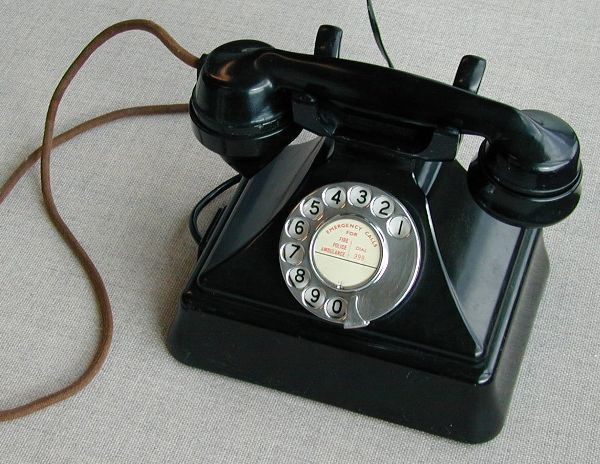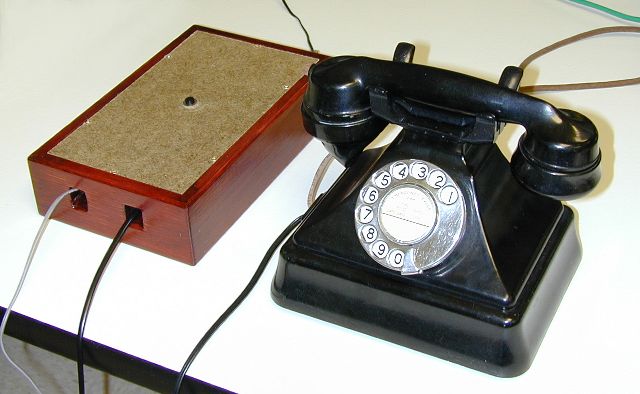
The phone and the English ringing converter in it's wooden case:

This is the homepage for a multi-year project that began in late '90s to make a British telephone ( a GPO model 192 with a model 31 bellset ) work on an American network, but with the traditional English double ring.
While working at Media Link in Seattle ( a Paul Allen startup company making telephones work across an ethernet network ), I met Phil Herres. He was friends with Rosemary who grew up in England. She had fallen in love with the lovely sounds and style of the English phones of her native land. She had brought back an older English telephone, and asked Phil to make it ring just like it did over in England. Phil knew that I was adept a telephone electronics having designed the hardware and software for the Media Link station adapter ( providing battery, ringing, off-hook detection and a codec interface ). He asked me as a favor to take on the project, while he did the background research for the specifications.
As a bit of background:
I've also worked in England on the phone exchanges. In the mid '80s, I was working as a contractor for IBM on a project in Leicester to extract detailed billing records from the step-by-step and crossbar exchanges. The system was designed to replace the old system of having banks of meters that counted pulses off the trunks and were quarterly photographed to generate bills. It was great fun working in the step offices and listening to the clatter of the Stroger switches routing calls around the office. The English use a double ring to alert the subscribers as opposed to the American system that uses one long ring.
So I designed up a bit of hardware to do all the basic functions: detect ringing, generate loop current, generate ringing, detect loop current, and switch the phone between the ringing supply and the network. If you would like the technical details of how it works, you'll find a discussion of it here: ( ERC Technical Description )
Having wired the phone up and connecting it to a CO simulator, I found that the transmitter worked fine, but the receiver didn't. Carefully examining the phone showed that it had been significantly modified from the 196 schematic I had. The hookswitch was only half wired and it didn't have as many contacts as the schematic showed ( probably salvaged from a GPO model 232 phone ). So I bit the bullet and took the phone apart. The original wires to the hookswitch had been cut and replaced with a single modern green wire. Fortunately, because the original wires were there, I was able to salvage them and restore them to something close to the original schematic. The 196 didn't come with a dial, so I had to figure out the best way to connect it.
The toughest part of the project was figuring out how to wire the parts of a 1930's era phone together so that it would work as originally designed. Unlike modern phones, early phones had separate bellsets that held part of the telephone electronics. The early candlestick style phones had the bells mounted in a box on the wall. This phone was one of the early ones to have the bellset attach to the body of the phone ( it could also be optionally attached to the wall like the earlier candlestick phones ). I had schematics for the phone and schematics for the bellset, but unfortunately, no schematic to show how to wire the two of them together correctly. After many unsuccessful attempts to wire the two parts of the phone together, I finally got in contact with Bob Freshwater who has an excellent web page: ( Bob's Telephone File ). He was able to supply me with a schematic that detailed how to wire the two together. Thanks Bob!
The goal was to have the phone ready by Christmas 2001, but unfortunately I didn't make it. Over the Christmas break, I was able to put a wooden case together for the electronics and add a pushbutton so Rosemary could demonstrate the ringing of the phone without having to call herself. Phil, Rosemary, and I finally got together in January of 2002 to deliver the phone to Rosemary after four years of waiting. She loved it! Her husband Scott was nice enough to capture a wave file of the ring. If you would like to hear it, just click here.
The phone:

The phone and the English ringing converter in it's wooden case:

Back to the TeleDesign Projects
Back Home to Strato Loft